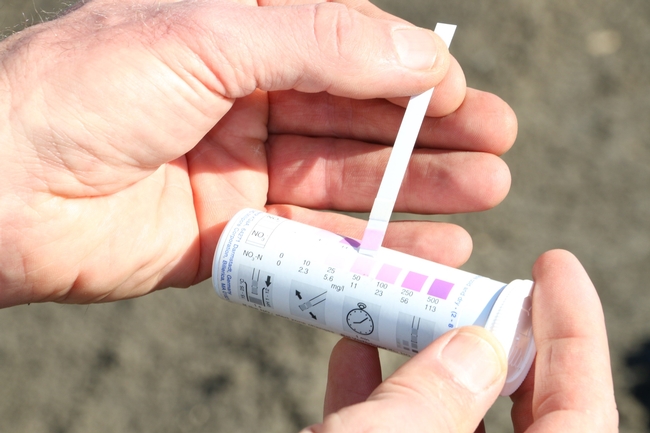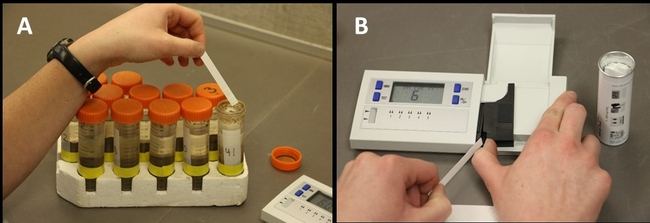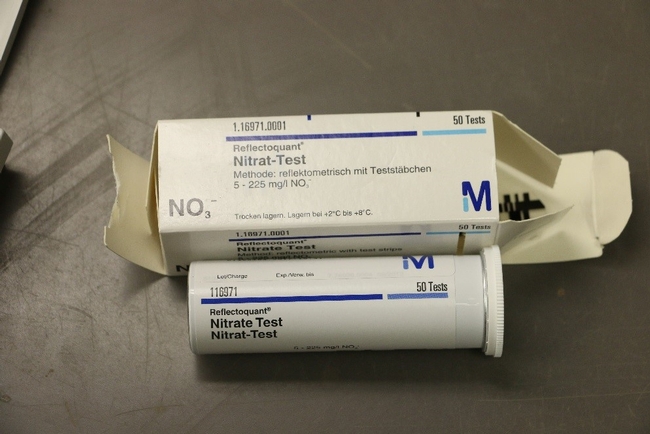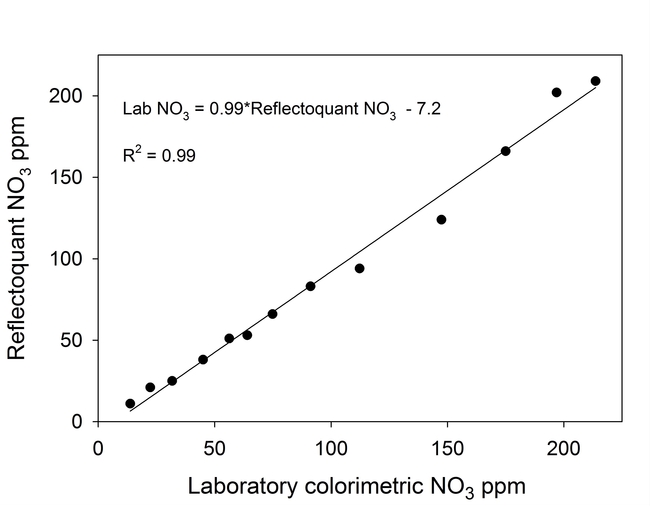Nitrate test strips are an affordable tool for quickly measuring nitrate (NO3) in soil and water, and can help growers and crop consultants adjust fertilizer inputs to match the nitrogen (N) needs of crops. A variety of brands of nitrate test strips are now available and were compared in a previous study. All of these strips are used in a similar fashion: the strip is briefly dipped into an extractant solution (for soil) or in water, and allowed to develop color during a standard interval of time, usually ranging between 30 and 60 seconds. After color develops on the strip, a color chart, calibrated to either parts per million (ppm) of NO3 or equivalent ppm of nitrogen (NO3-N), is used to determine the NO3 concentration of the sample (Fig. 1). Dividing nitrate concentration by 4.43 converts the value to NO3-N concentration.
Figure 1. The nitrate test strip is compared with a color chart to estimate the nitrate concentration of the soil extract solution or water sample.
A previous study that we conducted demonstrated that the Mquant (also known as the Merckoquant) brand was one of the most accurate and reliable nitrate test strips. However, the main limitation to using nitrate test strips is accurately interpreting the color. One needs good lighting to judge the color of the strip, and some users are partially or fully color blind. At high nitrate concentrations, it is difficult to interpret the nitrate concentration if the strip color falls between 2 calibration colors. For example, on the Mquant strip, the high concentration colors correspond to 100, 250 and 500 ppm NO3 (23, 56, 113 ppm NO3-N). Often the strip color is darker than the 100 ppm but lighter than 250 ppm, so it is difficult to decide the exact nitrate concentration of the sample.
RQflex 10 reflectometer (Fig. 2) is a small instrument that uses reflected light to quantify the color of test strips. It requires using the Reflectoquant brand of test strips (Fig. 3) which includes a calibration card to assure that the instrument is standardized to the batch of strips used for the nitrate measurements. Once calibrated, the instrument provides digital readings of the nitrate concentration in units of parts per million (ppm) NO3. Note that readings must be divided by a factor of 4.43 to convert to NO3-N equivalents. We compared the Reflectoquant strip readings of standard nitrate solutions using the RQflex with a colorimetric method used at our laboratory. Results showed an almost 1:1 correspondence between the Reflectoquant and laboratory readings (Fig 4).
Figure 2. Nitrate concentration can be measured using the Reflectoquant test strip and the RQflex reflectometer. The strip is dipped in the extractant solution (A) and allowed to develop color for 1 minute before making a reading using the RQflex (B).
Figure 3. The reflectoquant test strips must be used with the RQflex reflectometer to assure accurate measurments of nitrate.
Figure 4. Comparison of nitrate values of standard solutions made with the reflectoquant test strips and the RQflex reflectometer and using a colorimetric laboratory method.
Although using the Reflectoquant strips appear to improve the accuracy of conducting the nitrate quick test, the main drawback is the extra cost compared to the Mquant strips. The Reflectoquant strips are more expensive ($1.8/strip) than the Mquant ($0.7/strip), and the RQflex reader may cost between $900 and $1100 depending if you purchase the RQflex 10 or RQflex Plus 10 model. The RQflex reflectometer can be used to measure other nutrients, including ammonium, nitrite, and phosphate using the appropriate test strips.
The nitrate strips and the RQflex reader can be purchased from several vendors, such as Millipore-sigma, Capitol Scientific, and VWR. Part numbers are: RQflex 10 Reflectoquant (116970), Reflectoquant nitrate strips (116971), Mquant nitrate/nitrite strips (110020).



